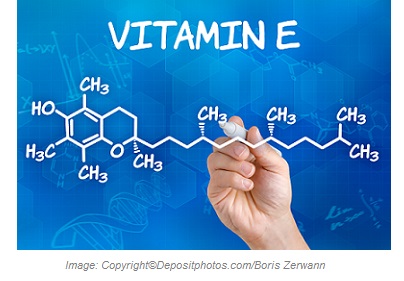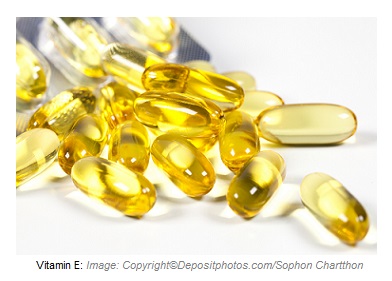Vitamin E is a fat soluble vitamin and a collective name for tocopherols and  tocoteriols. Being famous as the “fertility vitamin”, vitamin E acts as a potent antioxidant. Among the eight isomers of tocopherols, alpha – tocopherol and gamma – tocopherol are the two most common forms.
tocoteriols. Being famous as the “fertility vitamin”, vitamin E acts as a potent antioxidant. Among the eight isomers of tocopherols, alpha – tocopherol and gamma – tocopherol are the two most common forms.
Functions of Vitamin E:
- It acts as a chain – breaking antioxidant and scavenges the pyroxyl radicals.
- It inhibits the synthesis of prostaglandins and the activities of protein kinase C and phospholipase A2.
- It protects cell membranes, unsaturated fatty acids, adrenal hormones, and LDL cholesterol from oxidation.
- It protects the lungs from oxidative damage caused by environmental substances.
- It shows anti – inflammatory activity.
- It demonstrates anti – coagulating activity.
- It may prevent platelet aggregation.
- The function and effectiveness of vitamin E is enhanced by vitamin C, Co – Enzyme Q10, selenium, glutathione, and beta – carotene.
Food Sources and Absorption:
Vitamin E is found in wheat germ oil, safflower oil, seeds, nuts, whole grains, egg yolks, butter, milk, liver, and green leafy vegetables. It is absorbed along with fats and bile salts from the small intestine and then is transported to the liver. The absorption of vitamin E is decreased by chlorine and mineral oils. Estrogens may deplete vitamin E from the body. The absorption of vitamin E from the skin is poor.
Vitamin E is not stored as good and effectively as other fat soluble vitamins. However, small amounts are mainly stored in the fatty tissues and liver. It is also stored in the heart, testicles, adrenal glands, uterine, muscles and pituitary gland.
Athletic Benefits of Vitamin E: 
- It may prevent exercise – induced muscle damage.
- It has a protective effect against post – exercise rhabdomyolysis (post – exercise myoglobinuria). See “Post – Exercise Rhabdomyolysis” under the section of “Athletic Disorders”.
- It may prevent overtraining syndrome.
- It speeds up recovery from intense training sessions.
- It may boost the production of steroid hormones by the adrenal glands, supporting muscle growth.
- Also see “Vitamin E” under the section of “Testosterone Boosters”.
Non – Athletic Benefits of Vitamin E:
The following conditions may benefit from vitamin E:
- Anemia.
- Alzheimer’s disease.
- Epilepsy.
- Cancers (lung, colon, and prostate).
- Intermittent claudication.
- Infertility.
- Tardive dyskinesia.
- Skin problems, such as dermatitis, ulcers, lupus, burns, and allergies.
- Endometriosis.
- Dysmenorrhea.
- Premenstrual syndrome (PMS).
- Preeclampsia.
- Diabetes and diabetic retinopathy.
- Cold sores.
- Shingles (Zona).
- Fibrocystic disease of breast.
- Osteoarthritis.
- Rheumatoid arthritis.
- Strains and sprains.
- Lung disorders, such as bronchitis and cystic fibrosis.
- Eye problems, such as cataract and age – related macular degeneration.
- Cardiovascular problems, such as angina pectoris and hypertension.
- Leukoplakia.
- Compromised immune system.
- High LDL cholesterol.
- Fibromyalgia.
Dosage and Side Effects: 
See “Vitamin E” under the section of “Testosterone Boosters”.
Interactions:
- Warfarin: vitamin E may increase the risk of bleeding.
- Anti – platelet medications: vitamin E may increase the risk of bleeding.
- Levostatin: vitamin E may decrease the effectiveness of this medication.
- Ketoconazole: vitamin E may decrease the effectiveness of this medication.
- Estrogen – containing birth control pills: they may lower blood levels of vitamin E.
- Cyclosporine: vitamin E may increase its absorption and effectiveness.

